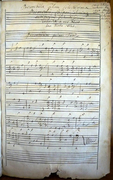A Previously Unknown Lute Tablature
Dr. Helmut Lauterwasser
Friday, January 27, 2017

We have received the following from Dieter Kirsch:
It doesn’t happen too often nowadays for objects to turn up in public collections that have so far managed to elude researchers. Such a case will be described below.
Among the music manuscripts housed at the Stadtbibliothek Braunschweig (D-BSstb), which are currently being cataloged by the Munich office of RISM Germany, there is a lute tablature with the shelfmark C 39 2° that is not documented in the standard source catalogs by Wolfgang Boetticher and Christian Meyer. The volume is a manuscript in a well-preserved leather decorative binding with gold tooling and 175 leaves total (RISM ID no. 1001001091). All leaves are lined with music staves but many of the staves are blank. In all, 64 pieces are written in French tablature notation, three of which—including a lute duet—are inserted as loose leaves. The music is for a seven-course (in two cases eight-course) lute in Renaissance tuning.
Right from the beginning, it is clear that the main copyist is a “Nicolao Ficcio” who informs us that he began the book in November 1594. The structure of the contents cannot be overlooked. Preludes that go through the church modes make up the beginning, followed by additional preambles that are numbered to 30. After a few empty pages there are four motet intabulations and, again after some empty pages, a sequence of passamezzos follows that is made up of 21 numbered sections. Only the headings remain of the corresponding saltarellos that were supposed to follow. Some pages on, the manuscript closes with a “Passomezo Milanese” and Polish dances in the hand of a second copyist.
Without a doubt, the manuscript originated in the eastern Baltic region. One indication of this is that the city of Riga is named in the title of the “Passamezo Milanese” (RISM ID no. 1001001664). Further proof lies in the composers named in the headings of some pieces: “Diomedes” (Diomedes Cato), “Caspari Sieleczkego” (Kasper Sielicki), and “Alberto Ambrosio Dlughoray” (Wojciech Długoraj) were all employed in Poland. More exact information still needs to be determined about two additional lutenists, “Beichovius” and “Spalkaiber” (Spalkauer?). Finally, the watermark also confirms the place of origin: the same paper is documented in Dorpat (Tartu) in 1594 and in Reval (Tallinn) in 1604.
The shelfmark C 39 informs us that the volume is from the private library of the Braunschweig jurist Johann Camman (1584–1649), whose valuable book collection formed the core of today’s Braunschweig City Library.
So far, concordances for 22 pieces have been found in printed editions with works by Matthäus Waissel (1573 and 1591), Giulio Cesare Barbetta (1582), and Emmanuel Adriaensen (1592). The remaining pieces are likely unique to this manuscript. It is not only this fact that lends the volume its particular importance. Its contents—as far as the entries by the main copyist are concerned—require a highly professional, demanding technique.
Altogether, we have a volume that opens up interesting new insight into the repertoire of the end of the sixteenth century and may perhaps encourage further investigation into the unknown musicians named within its pages.
I would like to especially thank Dr. Helmut Lauterwasser, who cataloged the manuscript and readily shared his knowledge with me.
Dieter Kirsch
Any questions concerning the cataloging of the Braunschweig holdings by RISM should be directed to Dr. Helmut Lauterwasser, Munich office of RISM Germany:
E-mail: Helmut.Lauterwasser[at]bsb-muenchen.de
Telephone: +49 (0) 89 28638-2884
Other questions concerning the manuscript (access, ordering reproductions, etc.) should be directed to the Stadtbibliothek Braunschweig:
E-mail: : stadtbibliothek[at]braunschweig.de
Telephone: +49 (0) 531 470-6835.
Image of C 39 2° courtesy of the Stadtbibliothek Braunschweig, published with kind permission.
Share Tweet EmailCatégorie: Redécourvertes

